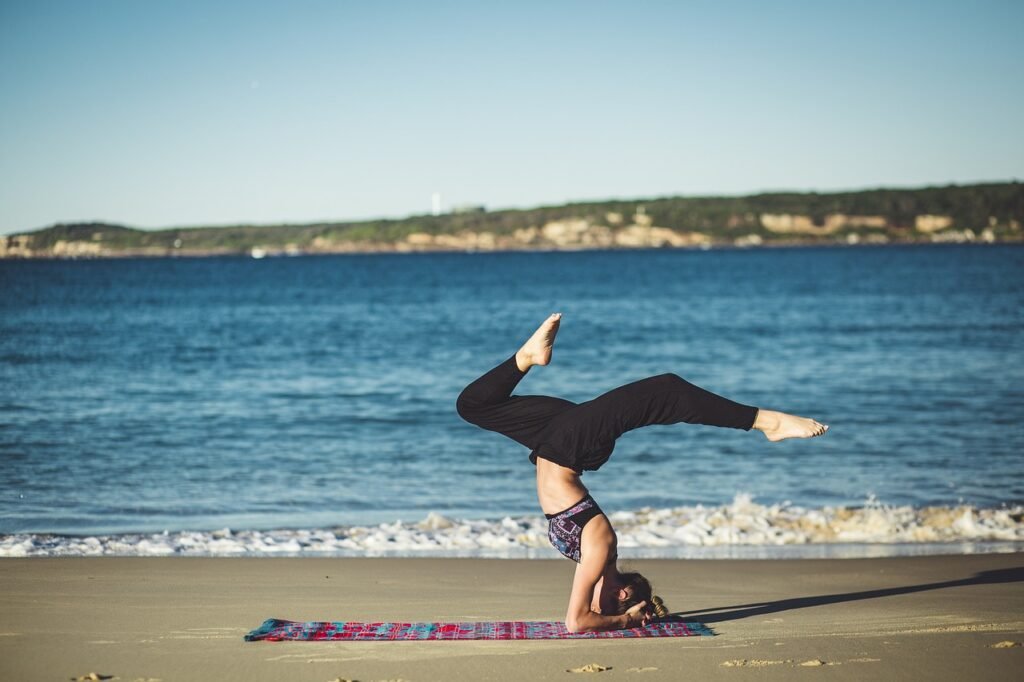If you’ve ever wondered whether yoga can help improve your balance, you’re not alone. With its focus on strength, flexibility, and mindfulness, yoga has become increasingly popular as a form of exercise. Many people are drawn to its holistic approach and the potential benefits it offers, including increased stability and better posture. So, if you’re looking to enhance your balance and overall well-being, incorporating regular yoga workouts into your routine may just be the key.
Understanding Balance
Balance is the ability to maintain control and stability of your body while performing various movements and activities. It involves the coordination of multiple systems in your body, including your muscles, joints, and sensory input. Whether you’re walking, running, or even just standing still, balance is a crucial aspect of your daily life.
Definition of Balance
In simple terms, balance refers to the ability to distribute your weight evenly and maintain proper alignment. It is the equilibrium between opposing forces that allows you to stay upright and steady. When your body is in balance, you feel centered and grounded, both physically and mentally.
Importance of Balance
Balance is not only essential for preventing falls and injuries but also for enhancing your overall performance in various physical activities. Whether you’re an athlete, a dancer, or simply someone looking to stay active and healthy, having good balance can greatly benefit you. It allows you to move with ease, grace, and confidence, thereby improving your posture, coordination, and even your self-confidence.
Factors Affecting Balance
Several factors can influence your balance. These include your age, muscle strength, flexibility, vision, inner ear health, and proprioception. While some factors, such as age and vision, may be beyond your control, others can be improved through targeted exercises and practices. This is where yoga comes in.
Introduction to Yoga
Yoga has been practiced for thousands of years and originated in ancient India. It encompasses physical, mental, and spiritual disciplines that aim to promote overall well-being and harmony within the body and mind.
Origin of Yoga
Yoga dates back over 5,000 years and finds its roots in ancient Indian philosophy and religious practices. It has evolved over time and gained international recognition as a holistic system for self-improvement and self-realization.
Definition of Yoga
The word “yoga” derives from the Sanskrit word “yuj,” which means to unite or join. Yoga seeks to cultivate a union between the body, mind, and spirit, fostering a sense of balance and harmony within oneself and with the external world.
Benefits of Yoga
Yoga offers a multitude of benefits, both physical and mental. Regular practice can improve flexibility, strength, and endurance while reducing stress, anxiety, and depression. It enhances mindfulness, promotes relaxation, and can even improve sleep quality. Additionally, yoga is known for its therapeutic effects on various ailments and conditions, making it a versatile and accessible practice for individuals of all ages and fitness levels.

This image is property of pixabay.com.
Yoga Poses for Balance
Yoga poses, also known as asanas, play a significant role in developing balance and stability. Through precise movements and focused attention, specific poses can challenge your sense of balance, allowing you to strengthen the muscles and systems involved in maintaining equilibrium.
Tree Pose (Vrikshasana)
The Tree Pose is a standing pose that challenges your balance by requiring you to stand on one leg while grounding through the stationary foot. By engaging the muscles in your standing leg and focusing your gaze on a fixed point, the Tree Pose not only builds stability but also improves concentration and body awareness.
Warrior III Pose (Virabhadrasana III)
The Warrior III Pose is an intermediate-level standing pose that demands focus and strength to maintain balance. From a standing position, you extend one leg back while simultaneously leaning forward, creating a straight line from your head to your extended heel. This pose engages your core, legs, and back muscles, promoting stability, core strength, and improved posture.
Eagle Pose (Garudasana)
The Eagle Pose challenges both your balance and flexibility by requiring you to wrap one leg around the other and cross your arms in front of you. This pose enhances stability in the legs and feet, strengthens the ankles, and improves concentration and focus.
Half-Moon Pose (Ardha Chandrasana)
The Half-Moon Pose is a standing balance pose that targets the legs, core, and sense of proprioception. From a standing position, you lift one leg and reach down with the opposite arm, creating a half-moon shape with your body. This pose not only improves balance but also opens up the hips, strengthens the core, and enhances overall body awareness.
Yoga for Core Strength
Core strength and balance go hand in hand. A strong core provides stability and support to your entire body, helping you maintain balance in various positions and movements.
Connection between Core Strength and Balance
The muscles in your core, including the abdominals, obliques, and lower back, provide a solid foundation for balance and stability. By strengthening these muscles, you improve your ability to maintain proper alignment, resist external forces, and stay upright in challenging positions.
Plank Pose (Phalakasana)
The Plank Pose is a basic yet powerful core-strengthening exercise that also challenges your balance. From a push-up position, you engage your abdominal muscles, keeping your body in a straight line from head to toe. This pose not only strengthens your core but also engages your arms, shoulders, and legs.
Boat Pose (Navasana)
The Boat Pose is a challenging pose that targets your core muscles while simultaneously testing your balance. From a seated position, you lift your legs and lean back, balancing on your sitting bones. This pose engages the abdominals, hip flexors, and lower back, cultivating core strength and stability.
Bridge Pose (Setu Bandhasana)
The Bridge Pose is a backbend that activates the glutes, hamstrings, and core muscles. From a lying position, you lift your hips, creating a bridge-like shape with your body. This pose not only strengthens the posterior chain but also promotes spinal flexibility and stability.

This image is property of pixabay.com.
Improving Proprioception
Proprioception, also known as kinesthetic awareness, is your body’s ability to sense its own position, movement, and orientation in space. It involves the integration of sensory information from various receptors, such as those in your muscles, joints, and inner ear.
What is Proprioception?
Proprioception allows you to have a sense of where your body parts are in relation to each other and the environment. It is what enables you to walk without looking at your feet or catch a ball without thinking about it. Proprioceptive awareness is crucial for maintaining balance and coordinating movements.
Importance of Proprioception for Balance
Good proprioception is essential for maintaining balance and preventing falls. It allows your body to make subtle adjustments in posture and alignment to keep you upright and steady. By improving your proprioceptive abilities, you can enhance your balance, coordination, and overall body awareness.
Yoga Exercises to Enhance Proprioception
Yoga incorporates various exercises and poses that can improve your proprioception. Balancing poses, such as the Tree Pose and the Warrior III Pose, challenge your body to make constant micro-adjustments to stay upright. These poses strengthen the muscles involved in proprioception and develop an acute sense of body awareness.
The Mind-Body Connection
In addition to physical benefits, yoga also nurtures the mind-body connection. By cultivating mindfulness and incorporating breathing techniques and meditation into your practice, you can further enhance your balance and overall well-being.
Role of Mindfulness in Balance
Mindfulness is the practice of bringing your attention to the present moment without judgment. When it comes to balance, mindfulness helps shift your focus away from distractions and external stimuli, allowing you to tune in to your body’s sensations, movements, and alignment. By staying present and mindful, you can make quicker adjustments and maintain better balance.
Breathing Techniques in Yoga
Yoga places great emphasis on breath control and regulation. By consciously controlling your breath, you can calm your mind, reduce stress, and improve your ability to find balance. Deep, slow breathing activates the relaxation response in your body, promoting a sense of calm and stability.
Meditation and Balance
Meditation is a practice of cultivating mental stillness and awareness. By incorporating meditation into your yoga routine, you can strengthen your concentration, reduce mental distractions, and improve your ability to find balance both on and off the mat. Consistent meditation practice can also lead to heightened body awareness and a greater sense of interconnection between your physical and mental states.

This image is property of pixabay.com.
Effectiveness of Yoga for Balance
Scientific studies have shown that yoga can be highly effective in improving balance, especially in older adults and individuals with certain health conditions. A study published in the Journal of Aging and Physical Activity found that a 12-week yoga intervention significantly improved balance and mobility in older adults, reducing their risk of falls.
Positive Outcomes and Benefits
Regular yoga practice can lead to improved balance, coordination, and body awareness. It enhances muscle strength, flexibility, and joint stability, all of which contribute to better balance control. Additionally, yoga’s focus on mindfulness and relaxation helps reduce stress and anxiety, which can be factors that negatively impact balance.
Limitations and Considerations
While yoga can be highly beneficial for balance improvement, it’s important to consider individual needs and limitations. Some yoga poses may not be suitable for individuals with certain health conditions or injuries, requiring modifications or alternatives. It’s important to practice under the guidance of a qualified yoga instructor who can provide appropriate modifications and ensure your safety.
Incorporating Yoga into Daily Routine
Incorporating yoga into your daily routine can be a transformative way to improve your balance and overall well-being. Whether you’re a beginner or an experienced practitioner, there are various ways to make yoga a part of your daily life.
Finding a Suitable Yoga Class or Instructor
Joining a yoga class or seeking guidance from a qualified yoga instructor can greatly enhance your yoga practice and help you progress safely. Look for instructors who have experience working with individuals of different ages and abilities, and find a class that aligns with your goals and preferences.
Creating a Balanced Yoga Practice
To make yoga a regular part of your routine, it’s important to create a balanced practice that incorporates different elements. This includes a mix of standing poses, seated poses, inversions, and twists to target various muscle groups and maintain overall body balance. It’s also beneficial to include breathwork, meditation, and relaxation practices to cultivate a holistic yoga experience.
Combining Yoga with Other Exercises
Yoga can complement other forms of exercise and physical activity. Incorporating yoga into your cross-training routine can help improve your performance in other activities, as well as enhance your balance and body awareness. Whether you enjoy running, weightlifting, or swimming, integrating yoga into your fitness regimen can offer additional benefits and help prevent imbalances or injuries.

Precautions and Safety Guidelines
While yoga is generally safe for most individuals, it’s important to take necessary precautions and follow safety guidelines to prevent injuries and ensure a positive yoga experience.
Consulting with a Healthcare Professional
Before starting a yoga practice, especially if you have any pre-existing health conditions or injuries, it’s advisable to consult with a healthcare professional. They can assess your individual needs, provide recommendations, and address any concerns you may have regarding your physical health.
Modifying Poses for Individual Needs
Each person’s body is unique, and it’s essential to listen to your body and modify poses as needed. Yoga poses can be adjusted to accommodate different abilities, flexibility levels, and body limitations. A knowledgeable yoga instructor can guide you in modifying poses to suit your individual needs while still reaping the benefits and ensuring your safety.
Avoiding Overexertion and Injuries
While it’s natural to challenge yourself in yoga, overexertion can lead to injuries and hinder your progress. It’s important to pace yourself, honor your body’s limitations, and avoid pushing beyond your comfort zone. Practicing mindfulness and listening to your body’s signals can help you avoid strains, sprains, and other yoga-related injuries.
Conclusion
Incorporating yoga into your life can be a powerful tool for enhancing your balance, strength, flexibility, and overall well-being. Through various poses, breathing techniques, and mindfulness practices, yoga offers a holistic approach to improving both physical and mental aspects of your health. Whether you’re looking to prevent falls, enhance athletic performance, or simply find a sense of inner peace and balance, yoga can provide the tools and guidance to help you achieve your goals. So, why not give it a try? Find a suitable yoga class or instructor, create a balanced practice, and embark on your journey towards improved balance and overall wellness. Your body and mind will thank you!


